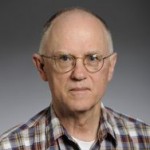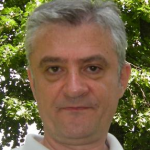Home › Forums › 2015 International Workshop on Quantum Foundations › Consistent histories › Consistent Histories Essentials
- This topic has 7 replies, 2 voices, and was last updated 8 years, 9 months ago by
 Miroljub Dugic.
Miroljub Dugic.
-
AuthorPosts
-
July 4, 2015 at 7:33 am #2462
 Robert GriffithsParticipant
Robert GriffithsParticipantBrief explanations are provided of three features that are central to the consistent histories (CH) interpretation of quantum mechanics and help distinguish it from other approaches: (i) Physical properties are represented by subspaces of the quantum Hilbert space. (ii) The single framework rule (SFR). (iii) Quantum dynamics is stochastic rather than deterministic.
July 15, 2015 at 7:09 am #2758 Miroljub DugicParticipant
Miroljub DugicParticipantDear Robert,
if instead of projectors, i [try] to define history via mixed states (density matrices), what might the consistency condition look like? Should i start from the spectral decomposition of the state that should serve analogous role to a choice of the unity decomposition in the standard definition of history?
Best regards,
Miroljub
July 16, 2015 at 9:22 pm #2812 Robert GriffithsParticipant
Robert GriffithsParticipantDear Miroljub,
I am not sure how to answer your question, but let me make the following comments, so you can see where my thinking is going.
The most common usage of density operators in ordinary quantum mechanics is, in the CH perspective, that of assigning probabilities to a quantum sample space at a single time, that is, to a projective decomposition of the identity (PDI). For example, in the formula Tr[rho P], where rho is the density operator and P a projector, a probability is assigned to the property represented by P; more generally, when sum_j P_j = I, one has Pr(P_j) = Tr[rho P_j]. So just as in standard probability theory one has a probability distribution which is be distinguished from an ‘event’ (to which a probability is assigned), I consider rho to be ‘like’ a probability distribution, but because one is often interested in various incompatible PDI’s, and rho can be used to set up a probability distribution on any one of them, I call rho a “pre-probability”.
Consistency conditions refer to a collection of histories, corresponding to some PDI on the history Hilbert space, and the issue is assigning a probability distribution using the generalized Born rule. The consistency conditions limit the sorts of families of histories (of a closed system) to which probabilities can sensibly be applied in this manner. You may be asking whether in place of one (or more) of the properties at a particular time one can use a pre-probability rho, and my immediate response is that I don’t see the physical motivation for it, why it would make sense. The classical analog would be that in some stochastic process in place of a state j at some time, to which the process will assign a probability, you want instead to employ a probability distribution. I cannot say that this is a silly idea, but I would want to know more about what physical process you are trying to model in this way. And the same thing in the quantum case. Is there something to be gained, and if so what?
Some years ago David Mermin published stuff in which he treated a density operator as something like a physical property, and I suspect there are many others who have similar ideas. But I myself have never found this helpful.
I hope the above goes some way towards addressing your question.
Bob Griffiths
July 17, 2015 at 7:02 am #2819 Miroljub DugicParticipant
Miroljub DugicParticipantDear Robert,
your words “You may be asking whether in place of one (or more) of the properties at a particular time one can use a pre-probability rho, and my immediate response is that I don’t see the physical motivation for it, why it would make sense. The classical analog would be that in some stochastic process in place of a state j at some time, to which the process will assign a probability, you want instead to employ a probability distribution” properly describe my question.
There are a few reasons backing my question.
First, as you say in your reply, mixed states (ensembles) are often regarded on the equal footing as the pure states, even for single systems (single elements of an ensemble). This attitude seems unavoidable in Quantum Information/Computation.
Second, mixed states (density matrices) are simply a part of the formalism e.g. in the open systems theory and at least formally should be considered — i understand your position and reluctance, but mathematical completeness has always been important to me.
Finally, there is a physical motivation that you may not be interested in — it can be found in ‘Other topics’ of this forum. To this end, it may be better, IF you find it relevant, to continue our discussion via email; if so, please let me know.
Best regards,
Miroljub
July 17, 2015 at 5:51 pm #2845 Robert GriffithsParticipant
Robert GriffithsParticipantDear Miroljub,
Let me respond to each of your points in turn.
1. Mixed states are often regarded on an equal footing with pure states.
There is no problem as long as both mixed and pure states are considered pre-probabilities, i.e., they generate probability distributions on properly defined sample spaces. But one should not confuse probabilities and their referents, i.e., the events of which they are probabilities; conceptually these are two very different things in ordinary probability theory as well as in applications of probability theory in quantum mechanics. I know of no situations in quantum information/computation which require ignoring this distinction. You will find some discussion of quantum information in Sec. 7 of “A consistent quantum ontology”, Stud. Hist. Phil. Mod. Phys. 44, pp. 93-114. arXiv:1105.3932v2.
2. Mixed states are part of the formalism.
I agree, but then one should use them consistently in an appropriate way as I have indicated above. Your are proposing, or so it seems to me, something that is not appropriate.
3. I am not enthusiastic about introducing multiple times when the quantum formalism seems to work perfectly well with a single time. I see no reason to make things more complicated.
Bob Griffiths
July 18, 2015 at 8:52 am #2856 Miroljub DugicParticipant
Miroljub DugicParticipantDear Robert,
many thanks. May i conclude that on the interpretational side of CH, formal use of density matrices instead of the projectors is not consistent?
btw, i am not sure at which point of ‘multiple time’ you have encountered complications. Technically and also intuitively, the scheme is rather simple [and appears to be useful].
Best regards,
Miroljub
July 18, 2015 at 6:30 pm #2876 Robert GriffithsParticipant
Robert GriffithsParticipantDear Miroljub,
In reply to your first remark, replacing projectors with density operators does not make much sense to me, but maybe there is a way to do it that is interesting. One might, for example, purify the density operator by using a reference system, still regarded as part of the closed system whose overall history one is trying to describe, assume trivial unitary time evolution for the reference system, as is sometimes done in quantum information discussions, and apply consistency by demanding that the off-diagonal elements of the Gell-Mann and Hartle decoherence functional vanish. This is vaguely similar to what I and two collaborators did in [1]. We had a definite physical motivation for doing so, and I don’t know how it might work out in some other case.
Relative to your second remark. I remember looking at a paper which employed multiple times. Not closely enough to spot any technical difficulties, but I also didn’t see why it was of that much interest. If using a single time suffices for describing what one is interest it, what advantage is there to using several?
Bob Griffiths
[1] Patrick J. Coles, Vlad Gheorghiu, Robert B. Griffiths,
“Collisional decoherence of tunneling molecules: a consistent histories treatment” Phys. Rev. A 86 (2012) 042111; arXiv:1205.6188July 18, 2015 at 9:40 pm #2885 Miroljub DugicParticipant
Miroljub DugicParticipantDear Robert,
many thanks for very useful and clear answers. I am note yet sure, but i might get back to you via email, if I follow my own question(s) in the directions suggested by your advices.
Regarding many times [‘local time’], which i believe you’re not interested in, just briefly about motivation and the results obtained so far.
Motivation: It’s a natural option within a minimalistic reading of the most basic kinds of physical interactions – in the quantum [many-body] scattering. Another option, of course, is unique time. ‘Minimalistic’ in my use of this word means: ‘add nothing but unavoidable’. As unique time is not unavoidable, we took another, equally valid [and rather intuitively clear] route.
Results: Technically simply reproduces the basic results/conjectures on small (few-body) and large (many particle) systems, routinely describes measurement, resolves the ‘preferred basis problem’ [without invoking ‘collapse’, environmental decoherence or any interpretation–which are required in the unique time QM], and offers a natural interpretation of the Wheeler-DeWitt equation [that is still open in physics of unique time]. And all that without intention–all those have just popped out.
Best regards,
Miroljub
-
AuthorPosts
- You must be logged in to reply to this topic.

Comments are closed, but trackbacks and pingbacks are open.